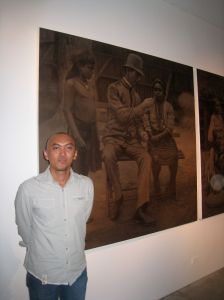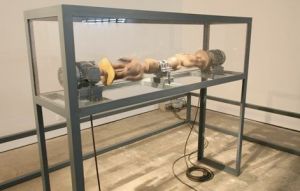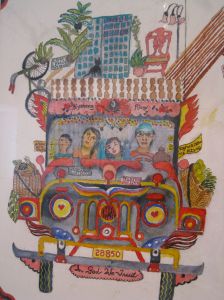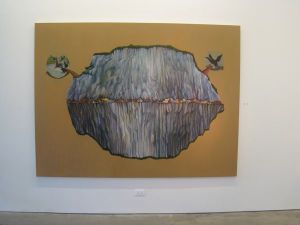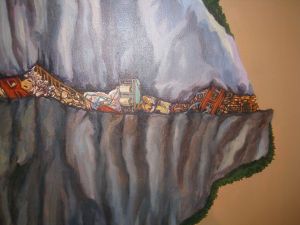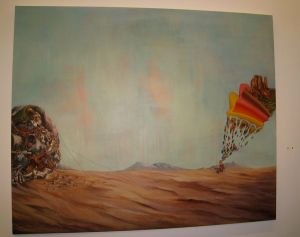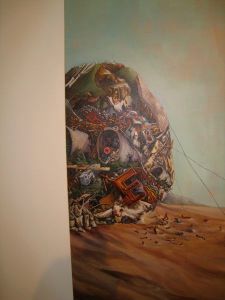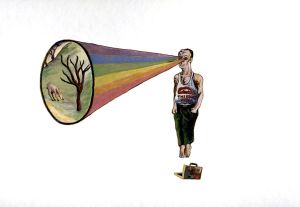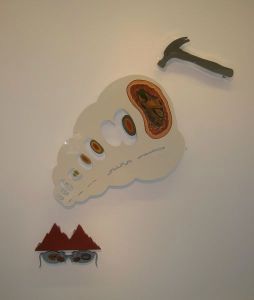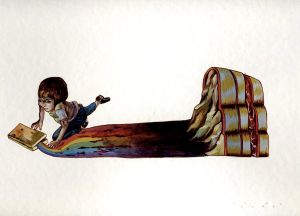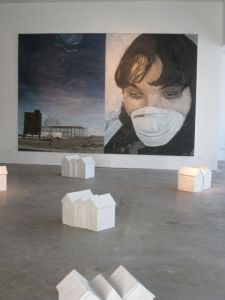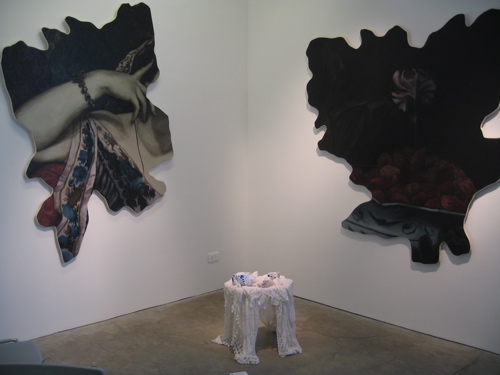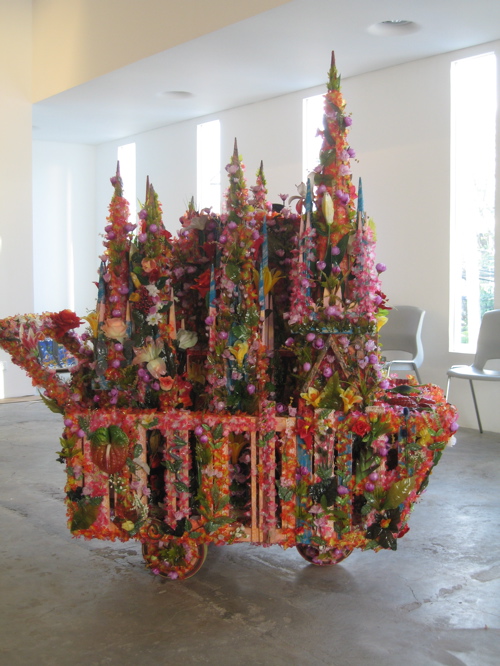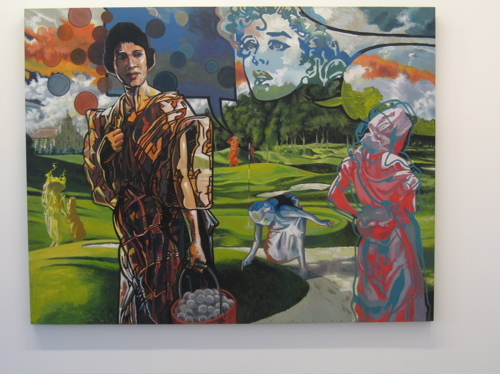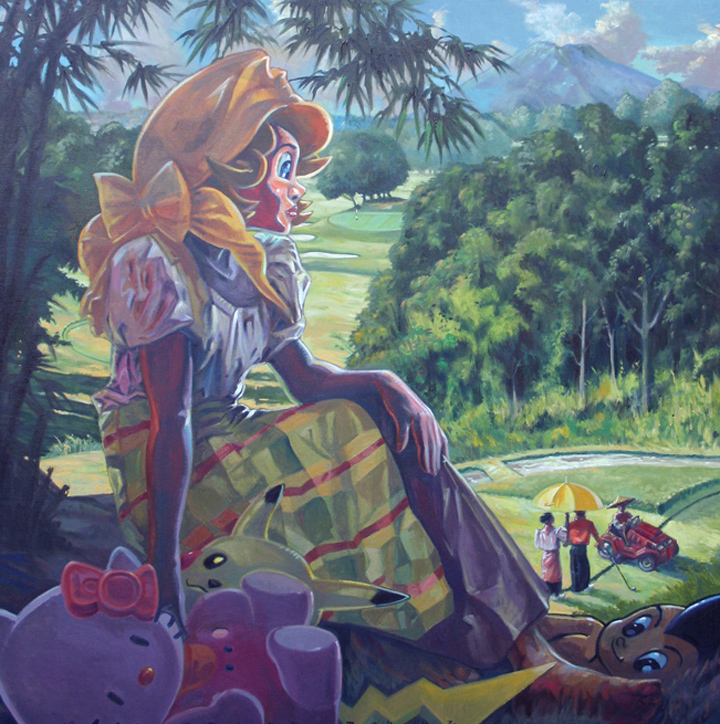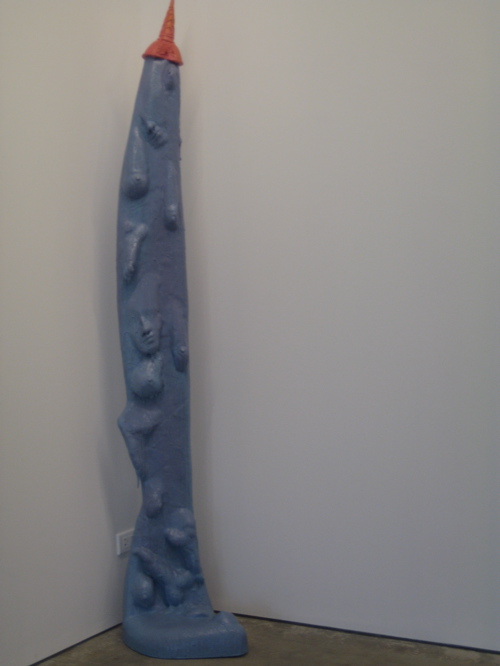Mark Justiniani likes to play. Not many people know that Mark uses clay to prepare for his paintings. He molds his figures, shapes them with his hands, and creates miniature tableaux of his narratives. He studies the resulting three-dimensional scenes for nuances of light and shadow that he translates into his painted images.

Detail, "Aiming for Windmills"
Mark Justiniani enjoys paradoxes. His pieces, especially his paintings on canvas and on wood, frequently employ graphic puns that fool around with the titles of his pieces or the absurdity of his images. He also enjoys working with mirrors, using them as devices to aid his visual tricks. For his 2005 piece, Bipolar, he attached a scratchboard that spelled out God against a mirror of roughly the same size. Seen through the mirror, his stylized letters transform into the word Bad. Mark loves to dwell on these juxtapositions, this coming together of opposite sides.
Mark Justiniani identifies with the Pinoy. His love for Philippine language, history, and culture pervades throughout his work. He peppers his visuals with uniquely Pinoy touches: Jose Rizal holding on to a flagpole for dear life, the Illustrado who wears a hat too big for his head, OFWs sailing away on a fragile paper boat. Underlying this is a close affinity to Pinoy humor. Even as he tackles the social realities of the day, Mark’s pieces retain the sense of self-deprecating whimsy that is so Filipino.

Detail, "Aiming For Windmills"
Mark Justiniani brings all these together, crystallizing all the elements that he uses as an artist, into a show of supersized proportions. Working with curator Patrick Flores, Mark propels to a new direction with Malikmata, a major solo exhibit opening this month at SLab.

Mark Justiniani "A Jar of Fireflies"
To move his art forward, Mark journeys back to his boyhood. He takes accoutrements from a bucolic childhood spent in the sugar fields of Bacolod, and morphs them into gigantic, interactive objects and installations in resin, glass, mirrors, and steel. Lola Basyang meets Anish Kapoor.
Malikmata means blink of an eye, and indeed, walking around his pieces will make viewers do a double take. Aiming For Windmills is a six-foot- high slingshot fabricated in steel, the two points of its yoke connected by a rubber band 20 feet long. It tilts to one side, ready to take aim with its bullet, a silicone head two feet in diameter. A resin palm-sized firely hovers in its vicinity.
As a young boy Mark ran around catching spiders. He sat listening to tales of aswang and duwende. He snuck out at dusk chasing fireflies. His pieces allow you to glory in these reminiscences.
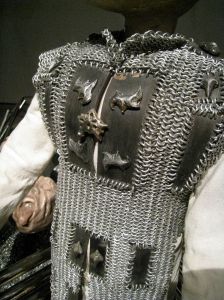
Detail of Agtabayon's chain mail with carabao horn inserts
Marvel at Collision, the four-foot -long matchbox of resin and steel, painted to resemble the box of Sunset matches from the 1970s, slid open to reveal enormous crossed matchsticks and Agtabayon, a pre-colonial Filipino diety in full battle armor. He fiercely protects the Philippines against a menacing spider decked in the battle gear of a Spanish conquistador. Waiting in the wings, ready to spin its deadly web is another spider who symbolizes the American invader. With its multiple components, I find this to be the most interesting piece of the show.

Mark Justiniani, "Collision"
Feel the sides of the man-sized Jar of Fireflies, made to simulate glass, translucent from the glow of fist-sized fireflies electronically blinking from within. Peer through peepholes that bore through three sides of Council, a nuno sa punso’s chest-high mound of fiberglass and steel shavings. Each set of peepholes show the goblins in varying states of battle. Avoid the stare of the fiberglass tikbalang mounted high on a resin shirt of a child it has preyed on.

The pre-colonial diety, Agtabayon, standing up against the Spanish conquistador spider
As Patrick Flores describes it, Mark “…lapses into childhood in this exhibition, a wonderful place to be …he is able to take a pause from painting to recover the sense of play and image before “art.” It is a transition period in his practice, and uncannily he surrounds himself with artifacts of perception or the “techniques of the observer” that afford him a double vision, so to speak: a look back at the past and a glimpse into a possible future.”

Detail of spider as spanish conquistador
Mark Justiniani spent months doodling, filling six sketchbooks with ideas for this show. He forged and reforged maquettes in clay. He built wooden prototypes and consulted with experts. All his energies culminate in this fantastic display that Manila’s art scene has not witnessed before.

Mark Justiniani, "Ligaw'
One piece in this exhibit stands out for its normal proportions. Inscribed on a strip of metal, which he pleated just as an accordion, are the words Tayo Na Kinupkop Sa Sinag ng Dilim. Stand to the right and the words blend together to read Takipsilim. Dusk. That special time when day melds into the night, and it is neither light nor dark. A paradox that Mark Justiniani revels in, that point of evolution that echoes just where he himself currently stands.

Detail of spider as an American GI

One view of "Takipsilim"
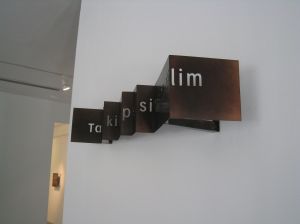
Another view, "Takipsilim"
Malikmata runs from 19 February to 13 March 2010 at SLab, 2F YMC Bldg. 2, 2320 Pasong Tamo Extension, Makati City. Phone (632)816-0044 or visit http://www.slab.silverlensphoto.com

Mark Justinian, "Ligaw" at upper left, and "Council"
Note: This post is reprinted from an article I wrote for the February 2010 issue of Rogue Magazine. See http://www.rogue.ph

Julie Lluch, Mark Justiniani, Gilda Cordero Fernando, Dawn Atienza, and Joy Mallari

Haraya Ching takes a peep into Council

A peep through "Council"
http://www.youtube.com/watch?v=bsQ_W0mgrKk


